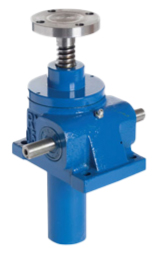When It Comes to Linear Motion, Screw Jacks Are Your Solution
|
Also referred to as machine screw jacks, worm gear jacks are the most common type of screw jack. The advantage of this type of screw jack is that they use an acme, or trapezoidal lead screw, which can lift heavy loads and self-lock to resist back driving. Their internal gear ratio results in the ability to lift, lower, push, or pull large loads with a relatively small amount of input torque. Worm gear screw jacks are also very good in multiple jack systems, because the torsional deflection of connecting shafts and couplings has little effect on positioning. Worm gear screw jacks have lower speeds and efficiency than other types, so they are best used for applications where the lifting, lowering, pulling, or pushing does not have to happen very quickly or often. Common uses of worm gear screw jacks are to lift platforms, roll stands, oven hoods, etc. |
|
|
Ball Screw Jacks use a ball screw and nut made from hardened alloy steel with ball bearings carrying the load between the nut and screw. The rolling of the ball bearings greatly reduces the friction between the nut and screw, allowing for smooth movement and providing much higher levels of efficiency than worm gear or bevel gear jacks. That efficiency ultimately means that a lower horsepower motor can be used to power the jack in heavy duty cycle applications. They also deliver excellent positional accuracy in high speed applications. The primary disadvantage of ball screw jacks is that they are not self-locking, meaning that you will need to incorporate a brake or motor with enough holding torque to prevent back driving. Common uses of ball screw jacks are fast cycle applications requiring oscillating motion, like controlling saw blade position, blade pitch and directional position on wind turbines and moving the gates within hydro-electric and waste management stations. |
|
|
Bevel gear jacks often use the same trapezoidal or acme screws found in worm screw jacks to move and position the load. The difference is that bevel gear jacks have bevel gears inside the housing instead of worm gearing. The primary benefit of bevel gear jacks is that they are more efficient than worm gearing—up to 60% compared to 20%—and they have lower ratios that result in higher speeds and travel rates. Bevel gear jacks are also provided with ball screws further increasing efficiency and speed capabilities. Typically, bevel gear jacks with trapezoidal screws maintain the self-locking characteristics of worm gear screw jacks while providing higher travel speeds. A brake or holding torque is require for bevel gear jacks using ball screws. Another benefit is that they are available in one, two, or three shaft configurations, making them ideal for multiple jack setups and eliminating the need for stand-alone right-angle gearboxes used in many worm gear and ball screw jack systems. Bevel gear screw jacks are used in many of the same applications as worm gear screw jacks, especially when multiple jacks or a faster speed are required. Typical projects include raising and lowering theatre stages, high speed carriages for loading and unloading product and a variety of automated assembly line applications. |
Why choose one type of screw jack over another?
Worm gear, ball screw, and bevel gear jacks are used for many similar applications:
- Positioning product loading and unloading tables, platforms or carriages
- Lifting and lowering large commercial oven hoods (cleaning, maintenance, etc.)
- Lifting food out of a commercial fryer
- Adjusting the gap and/or pressure between rollers on a printing or converting machine
- Positioning a saw blade or vibratory cutter
- Adjusting conveyor heights
- Opening and closing gates for water and waste management systems
- Positioning/tilting solar panels or antennas
- Positioning medical imaging components or patient tables
- Operating aircraft stabilizers
- Raising and lowering theatre stages
- Leveling or tilting heavy loads
- Replacing hydraulics to eliminate oil hazards, oil tanks, pumps, and hoses
- Mobile or outdoor lifting applications where hydraulics are not ideal or possible
The question is, why choose one over another? There are several factors to look at when choosing the right screw jack.
- Efficiency & speed – Bevel gear and ball screw jacks can be up to 60% efficient, making them ideal for applications requiring fast lowering, lifting, or adjusting.
- Duty cycle – This term refers to how often or how long the jack operates; worm gear jacks are not designed for applications with a duty cycle of more than 20%-30%.
- Positional accuracy – Ball screw jacks and bevel gear jacks are more accurate and repeatable compared to worm gear jacks.
- Self-locking – Due to their inefficiency, worm gear jacks are self-locking and will hold the load in place once positioned. A bevel gear jack may or may not be self-locking, ball screw jacks are not self-locking and will require an external brake to hold the load in place once positioned.
- Number of input/output shafts – Multiple jack systems using worm or ball screw jacks often require bevel boxes to turn the corner and to change direction of shaft rotation. Because of their flexible input/output shaft configurations, bevel gear jacks can eliminate stand-alone bevel boxes required in other systems, thus reducing the number of components and simplifying the system.
We can help you decide!
If you need help determining which type of screw jack is best for your project, then contact Candy Controls today. Our team will walk you through what makes each one qualified for particular linear motion applications.
Screw Jack Application Worksheet >Call Candy Controls Today!
 Candy Controls
Candy Controls


